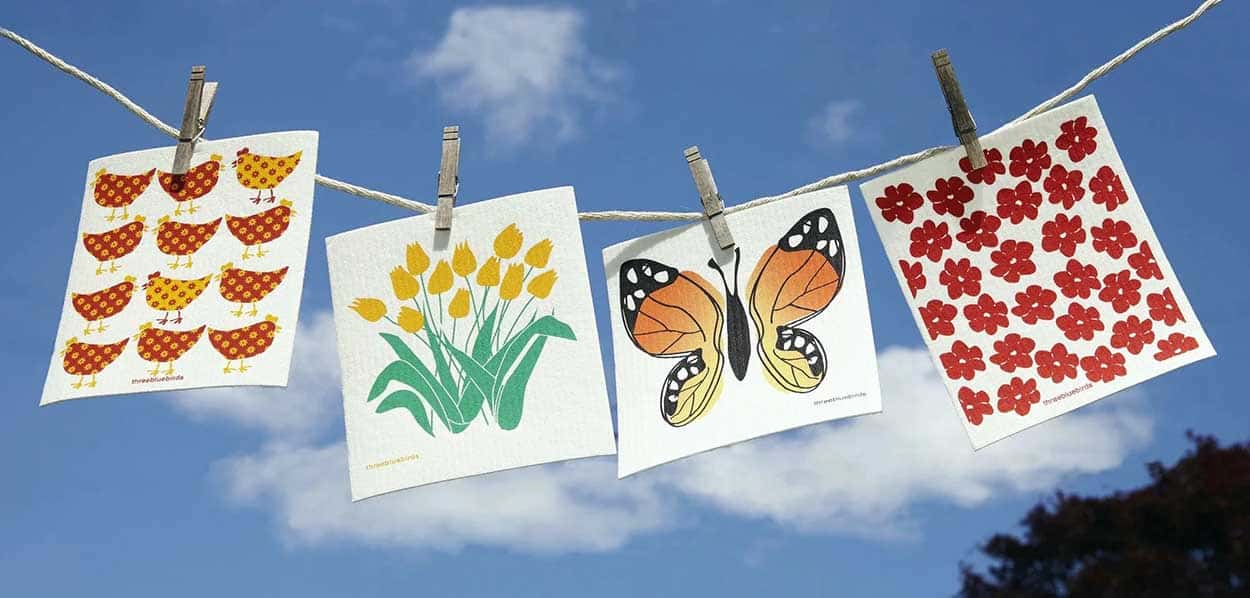Community Environment
Jennifer Preston: Here’s how to clean like the Swedes
Reusable and recyclable Swedish dishtowels last for months and are made from cotton and cellulose (wood pulp). Swedish inventor Curt Lindquist created them in 1949. Now, they’re manufactured all over the world in beautiful patterns and whimsical designs.
Most kitchen cleaning tools are made of plastics, like polyester or polyurethane. They are non-biodegradable, contribute to landfill waste and add microscopic plastics (a.k.a. “microplastics” or “MPs”) to our environment.
MPs don’t break down completely and water treatment plants cannot filter them out. They enter our rivers and seas, where fish and shellfish ingest them. In turn, we eat some of the fish and shellfish. MPs have been found on the floor of the Mariana Trench, the summit of Mount Everest, in apex marine mammals like orcas, even in our blood and lungs.
Microplastics and human health
Research on ecosystems reveal the toxic effects of MPs, including cellular malformation and cell death. They also increase abnormal immune responses and intestinal dysfunction. More studies are underway to better understand long term impacts on human health. For now, researchers say this is a problem we don’t know the extent of, and don’t have a solution for.
To make matters worse, many plastic kitchen sponges are treated with Triclosan, which is an anti-bacterial and anti-fungal chemical registered as a pesticide by the Environmental Protection Agency. It’s another element that water treatment plants cannot remove and now common in our waterways.
Now for the good news! We can reduce our exposure to and the proliferation of MPs with small changes to daily habits, which are also budget friendly.

Swedish dishtowels drying on a laundry line. Photo credit: Photos provided courtesy of Three Bluebirds
Swedish dishtowels
Swedish dishtowels are a sustainable, zero-waste alternative. They naturally degrade in the environment, which makes them an excellent replacement for single-use paper towels and non-recyclable sponges.
Locally, you can find them at Harbor Greens and Paper Luxe. The shops carry different styles from popular brands like Three Bluebirds and Potluck Press priced around $6.95. I keep several on hand: one ready at the sink for dishes and countertop messes, one for bathroom surfaces and one backup when its laundry time.
Over its lifetime, just one Swedish dishcloth can replace 15-17 paper towel rolls and multiple sponges. As for their care, it’s easy. Once or twice a week, toss them in the wash or dishwasher. Between uses, squeeze and air dry them on the sink or faucet.
Now you know how to start saving money and the planet by replacing that blue or green plast-icky dish sponge with this long-lasting, recyclable alternative. Take another baby step for Mother Earth.
Swedish dishtowel highlights
-
- Easy, effective cleaning with just cotton, cellulose and water
- Eco-friendly alternative to single use paper towels and plastic sponges
- Soft when wet, but tough enough to scour when dry
- Non-scratch, multi-surface safe for mirrors, marble, stainless steel, tile, wood and more
- Odor resistant and reusable. Wash them up to 50 times in the dishwasher or washing machine. (Do not put in the dryer.)
- Absorbs up to 20 times their weight
- Multi-purpose tool for scrubbing and drying
- 100% biodegradable and plant-based using sustainable cotton and cellulose
- Composts in 6-8 weeks and breaks down in landfills within 16 weeks
Five ways to start using Swedish dishtowels now
-
- Wipe down kitchen backsplashes, tile/granite/ laminate surfaces
- Wash dishes, pots and pans, just like you would with a sponge
- Create streak-free windows with a vinegar/water mix or commercial product
- Clean bathroom showers/tubs, fixtures and counters
- Keep one in the car for spill emergencies
Jennifer Preston Chushcoff of Gig Harbor is a writer, designer, former Master Gardener and self-described “eco-advocate.”
